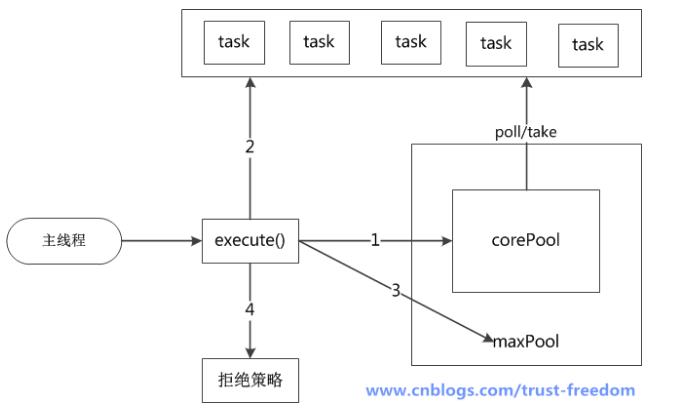Java线程池ThreadPoolExecuter:execute()原理
Posted 行路难
tags:
篇首语:本文由小常识网(cha138.com)小编为大家整理,主要介绍了Java线程池ThreadPoolExecuter:execute()原理相关的知识,希望对你有一定的参考价值。
一、线程池执行任务的流程

-
如果线程池工作线程数<corePoolSize,创建新线程执行task,并不断轮训t等待队列处理task。
-
如果线程池工作线程数>=corePoolSize并且等待队列未满,将task插入等待队列。
-
如果线程池工作流程数>=corePoolSize并且等待队列已满,且工作线程数<maximumPoolSize,创建新线程执行task。
-
如果线程池工作流程数>=corePoolSize并且等待队列已满,且工作线程数=maximumPoolSize,执行拒绝策略。
二、execute()原理
public void execute(Runnable command) { if (command == null) throw new NullPointerException(); /* * Proceed in 3 steps: * * 1. If fewer than corePoolSize threads are running, try to * start a new thread with the given command as its first * task. The call to addWorker atomically checks runState and * workerCount, and so prevents false alarms that would add * threads when it shouldn\'t, by returning false. * 如果运行的线程数小于corePoolSize,尝试创建一个新线程(Worker),并执行它的第一个任务command * 2. If a task can be successfully queued, then we still need * to double-check whether we should have added a thread * (because existing ones died since last checking) or that * the pool shut down since entry into this method. So we * recheck state and if necessary roll back the enqueuing if * stopped, or start a new thread if there are none. * 如果task成功插入等待队列,我们仍需要进行双重校验是否可以成功添加一个线程 (因为有的线程可能在我们上次检查以后已经死掉了)或者在我们进入这个方法后线程池已经关闭了 * 3. If we cannot queue task, then we try to add a new * thread. If it fails, we know we are shut down or saturated * and so reject the task. 如果等待队列已满,我们尝试新创建一个线程。如果创建失败,我们知道线程已关闭或者已饱和,因此我们拒绝改任务。 */ int c = ctl.get(); //工作线程小于核心线程数,创建新的线程 if (workerCountOf(c) < corePoolSize) { //创建新的worker立即执行command,并且轮训workQueue处理task if (addWorker(command, true)) return; c = ctl.get(); } //线程池在运行状态且可以将task插入队列 //第一次校验线程池在运行状态 if (isRunning(c) && workQueue.offer(command)) { int recheck = ctl.get(); //第二次校验,防止在第一次校验通过后线程池关闭。如果线程池关闭,在队列中删除task并拒绝task if (! isRunning(recheck) && remove(command)) reject(command); //如果线程数=0(线程都死掉了,比如:corePoolSize=0),新建线程且未指定firstTask,仅仅去轮训workQueue else if (workerCountOf(recheck) == 0) addWorker(null, false); } //线程队列已满,尝试创建新线程执行task,创建失败后拒绝task //创建失败原因:1.线程池关闭;2.线程数已经达到maxPoolSize else if (!addWorker(command, false)) reject(command); }
1. addWorker(Runnable firstTask, boolean core)
private boolean addWorker(Runnable firstTask, boolean core) { retry: //外层循环判断线程池的状态 for (;;) { int c = ctl.get(); int rs = runStateOf(c);//线程池状态 // Check if queue empty only if necessary. //线程池状态:RUNNING = -1、SHUTDOWN = 0、STOP = 1、TIDYING = 2、TERMINATED = 3 //线程池至少是shutdown状态 if (rs >= SHUTDOWN && //除了线程池正在关闭(shutdown),队列里还有未处理的task的情况,其他都不能添加 ! (rs == SHUTDOWN && firstTask == null && ! workQueue.isEmpty())) return false; //内层循环判断是否到达容量上限,worker+1 for (;;) { int wc = workerCountOf(c);//worker数量 //worker大于Integer最大上限 //或到达边界上限 if (wc >= CAPACITY || wc >= (core ? corePoolSize : maximumPoolSize)) return false; //CAS worker+1 if (compareAndIncrementWorkerCount(c)) break retry;//成功了跳出循环 c = ctl.get(); // Re-read ctl if (runStateOf(c) != rs) //如果线程池状态发生变化,重试外层循环 continue retry; // else CAS failed due to workerCount change; retry inner loop
// CAS失败workerCount被其他线程改变,重新尝试内层循环CAS对workerCount+1
} } boolean workerStarted = false; boolean workerAdded = false; Worker w = null; try { final ReentrantLock mainLock = this.mainLock; w = new Worker(firstTask); //1.state置为-1,Worker继承了AbstractQueuedSynchronizer //2.设置firstTask属性 //3.Worker实现了Runable接口,将this作为入参创建线程 final Thread t = w.thread; if (t != null) {
//addWorker需要加锁 mainLock.lock(); try { // Recheck while holding lock. // Back out on ThreadFactory failure or if // shut down before lock acquired. int c = ctl.get(); int rs = runStateOf(c); if (rs < SHUTDOWN || (rs == SHUTDOWN && firstTask == null)) { if (t.isAlive()) // precheck that t is startable throw new IllegalThreadStateException(); workers.add(w);//workers是HashSet<Worker>
//设置最大线程池大小 int s = workers.size(); if (s > largestPoolSize) largestPoolSize = s; workerAdded = true; } } finally { mainLock.unlock(); } if (workerAdded) { t.start(); workerStarted = true; } } } finally { if (! workerStarted) addWorkerFailed(w); } return workerStarted; }
addWorker(Runnable firstTask, boolean core)
参数:
firstTask: worker线程的初始任务,可以为空
core: true:将corePoolSize作为上限,false:将maximumPoolSize作为上限
addWorker方法有4种传参的方式:
1、addWorker(command, true)
2、addWorker(command, false)
3、addWorker(null, false)
4、addWorker(null, true)
在execute方法中就使用了前3种,结合这个核心方法进行以下分析
1、线程数小于corePoolSize。判断workers(HashSet<Worker>)大小,如果worker数量>=corePoolSize 返回false,否则创建worker添加到workers,并执行worker的run方法(执行firstTask并轮询tworkQueue);
2、线程数大于corePoolSize且workQueue已满。如果worker数量>=maximumPoolSize返回false,否则创建worker添加到workers,并执行worker的run方法(执行firstTask并轮询tworkQueue);
3.、没有worker存活,创建worker去轮询workQueue,长度限制maximumPoolSize。
4、prestartAllCoreThreads()方法调用,启动所有的核心线程去轮询workQueue。因为addWorker是需要上锁的,预启动核心线程可以提高执行效率。
2. ThreadPoolExecutor 内部类Worker
/**
* Class Worker mainly maintains interrupt control state for
* threads running tasks, along with other minor bookkeeping. * This class opportunistically extends AbstractQueuedSynchronizer * to simplify acquiring and releasing a lock surrounding each * task execution. This protects against interrupts that are * intended to wake up a worker thread waiting for a task from * instead interrupting a task being run. We implement a simple * non-reentrant mutual exclusion lock rather than use * ReentrantLock because we do not want worker tasks to be able to * reacquire the lock when they invoke pool control methods like * setCorePoolSize. Additionally, to suppress interrupts until * the thread actually starts running tasks, we initialize lock * state to a negative value, and clear it upon start (in * runWorker).
* 1.Worker类主要负责运行线程状态的控制。
* 2.Worker继承了AQS实现了简单的获取锁和释放所的操作。来避免中断等待执行任务的线程时,中断正在运行中的线程(线程刚启动,还没开始执行任务)。
* 3.自己实现不可重入锁,是为了避免在实现线程池控状态控制的方法,例如:setCorePoolSize的时候中断正在开始运行的线程。
* setCorePoolSize可能会调用interruptIdleWorkers(),该方法中会调用worker的tryLock()方法中断线程,自己实现锁可以确保工作线程启动之前不会被中断 */ private final class Worker extends AbstractQueuedSynchronizer implements Runnable { /** * This class will never be serialized, but we provide a * serialVersionUID to suppress a javac warning. */ private static final long serialVersionUID = 6138294804551838833L; /** Thread this worker is running in. Null if factory fails. */ final Thread thread; /** Initial task to run. Possibly null. */ Runnable firstTask; /** Per-thread task counter */ volatile long completedTasks; /** * Creates with given first task and thread from ThreadFactory. * @param firstTask the first task (null if none) */ Worker(Runnable firstTask) { setState(-1); // inhibit interrupts until runWorker //状态置为-1,如果中断线程需要CAS将state 从0->1,以此来保证能只中断从workerQueue getTask的线程 this.firstTask = firstTask; this.thread = getThreadFactory().newThread(this); } /** Delegates main run loop to outer runWorker */ public void run() { runWorker(this); //首先执行w.unlock,就是把state置为0,对该线程的中断就可以进行了 } // Lock methods // // The value 0 represents the unlocked state. // The value 1 represents the locked state. protected boolean isHeldExclusively() { return getState() != 0; } //在setCorePoolSize/shutdown等方法中断worker线程时需要调用该方法,确保中断的是从workerQueue getTask的线程 protected boolean tryAcquire(int unused) { if (compareAndSetState(0, 1)) { setExclusiveOwnerThread(Thread.currentThread()); return true; } return false; } protected boolean tryRelease(int unused) { setExclusiveOwnerThread(null); setState(0); return true; } public void lock() { acquire(1); } public boolean tryLock() { return tryAcquire(1); } public void unlock() { release(1); } //调用tryRelease修改state=0,LockSupport.unpark(thread)下一个等待锁的线程 public boolean isLocked() { return isHeldExclusively(); } void interruptIfStarted() { Thread t; if (getState() >= 0 && (t = thread) != null && !t.isInterrupted()) { try { t.interrupt(); } catch (SecurityException ignore) { } } } }
以上是关于Java线程池ThreadPoolExecuter:execute()原理的主要内容,如果未能解决你的问题,请参考以下文章